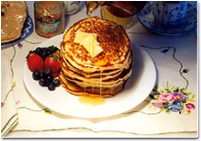

 MouseMaster MouseMaster Canadian Corner Canadian Corner Grammar Central Grammar Central Crazy English Crazy English Terrible Teacher Terrible Teacher Flashed ESL Flashed ESL American Stories American Stories
|
 |

Instructions: 1. Either print this exercise with the questions and complete them in a traditional fashion, or 2. Press to run a self-marked version of this exercise.  1. Cut down a sugar maple tree and you get firewood. Cut a small hole in a sugar maple tree and you get the sweetest natural taste in all of Canada: maple syrup. 2. Maple syrup is a sticky-sweet liquid made from the sap found inside the maple tree. It is the only Canadian pure natural sweetener other than honey available in a liquid form. The sugar maple, black maple, red maple and silver maple tree all produce the sweet sap it takes to prepare maple syrup.  3. The native people of eastern North America were the first to discover the sugary taste of maple sap. According to Iroquois Indian legends, natives cut into maple trees to find "sweet water" for use in cooking and curing their deer meat, or "venison". They also taught early European settlers methods of tapping maple trees and boiling down the sap. This process reduced maple sap to a syrup or a sugar slab the settlers could store for later use. 3. The native people of eastern North America were the first to discover the sugary taste of maple sap. According to Iroquois Indian legends, natives cut into maple trees to find "sweet water" for use in cooking and curing their deer meat, or "venison". They also taught early European settlers methods of tapping maple trees and boiling down the sap. This process reduced maple sap to a syrup or a sugar slab the settlers could store for later use.4. To pioneer farmers, the sugar maple tree served two useful purposes. First, the "hardwood" of the maple provided an excellent fuel for heating over the long harsh Canadian winter. Second, sugar maples provided the farmers with enough sap to make "maple sugar." This was an important food item for early settlers, since imported cane sugar was very costly and not always available to buy. 5. As more settlers arrived in Canada's rural areas, maple production began to increase. Large areas of forest were often cleared of all trees except the maple in order to increase production. These areas were called "sugar bushes" and provided farmers with extra money from the sale of maple sugar and maple syrup. 6. A variety of methods have been used to gather sap. Early settlers cut or "tapped" trees using axes and gouges. The sap flowed into buckets, and was then boiled in huge kettles made of iron and copper. This method of tapping was eventually abandoned due to the damage the axes caused to the trees. 7. Modern sugar bush operations collect sap using a vacuum tubing system. Flexible plastic tubes are inserted into holes bored into the trees. In early spring the combination of warm days and cool nights causes pressure to build inside the tree. This pressure forces a natural flow of clear sap into the collection system. The raw maple sap is evaporated, then further reduced to remove excess water. The end result is pure maple syrup. 8. It takes approximately 40 litres of maple sap to make just 1 litre of pure maple syrup. The syrup is graded according to its colour, flavour and density. Most of the maple syrup produced in Canada is exported to the United States. Small amounts are exported to Europe and Japan, where Canadian maple syrup is considered a treat for special occasions. 9. From the leaf on our flag to the syrup on our breakfast table, Canadians owe a great deal of their heritage to the mighty maple tree. |
 |
 | ||
Copyright © 2006 Centre for Education & Training. All Rights Reserved